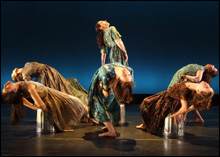
NORDIC RITE: Dievas Mannu/Full Moon incorporated shamanistic chants, mumbling voices, wolfish barks, and bearish growls.
|
Diane Arvanites-Noya and Tommy Neblett’s new duet, premiered at Boston Conservatory during Prometheus Dance’s Memorial Day weekend performances, seemed to be a philosophical model for the other new works on the program. Eyes Inside, set to the third movement of the Beethoven String Quartet No. 16, was a chain of renewed interdependencies.The slight, fragile Noya and the heavyset Neblett looked ill-matched, but it was only their body types that contrasted. As they took turns sliding, holding, cradling, and resting against one another, they seemed to be parts of a single organism whose elastic properties allowed them to separate and restore their unity, over and over again.
One dancer would remain still while the other moved, as if they were holding an amiable conversation. Sometimes they’d exchange roles in the repeat of a phrase. Noya often anchored an invisible circle as Neblett flared around her and linked back into her turning phrase. Other times she would disappear behind his back and emerge, legs akimbo, the rest of her wrapped around his shoulder. One of them would be pulling the other along the floor, and suddenly they’d both pivot into an embrace. The movements they devised to create this image of complementarity were continuous, beautiful, and surprising.
This dance was short and succinct. The other new works on the program were more extended, less economical in their use of the movement vocabulary, and sometimes overwhelmed by their theatrical additives.
Troika, for two sets of women, explored the idea of support, togetherness, and limited freedom. Three young dancers (Martha Stone, Ashley Williams, and Megan Schenk on Thursday night) and three members of the Elders Ensemble (Eleanor Duckworth, Joan Green, and Karen Klein) began the piece locked in a line, with one woman draped over the arms of the other two.
The first group made small, individual excursions into space and returned to their waiting teammates, first at a light, fast pace. After a slower, more languorous section, they were flinging themselves at each other, almost out of control but always safely caught.
The older women’s version of this was terse and sedate. You could see that they were strong and speedy, but sometimes they seemed to be doing rehearsed or simulated teamwork, rather than tapping into the spontaneous timing and adaptability that held the other group together.
This dance was accompanied by recorded pieces by the Czech artist Iva Bittova, who plays tabla and violin and vocalizes with rhythmic syllables, preverbal cries, and evocative tunes. The score created an emotional counterpoint to the dancers’ neutrality. I thought the Elders’ long black dresses made them look like reclusive widows going to church, which distracted me from what I took to be the main movement idea, their engaged and energetic longevity.
Another riveting score, by the Finnish composer Wimme Saari, accompanied Dievas Mannu/Full Moon, for seven women in folkloric tunics and pants with ankle bells. The music incorporated shamanistic chants, mumbling voices, wolfish barks, and bearish growls. Snow fell into a circle of light in one corner. A shadowy moon appeared and faded. All of this suggested some kind of ritual in an unforgiving land — a Nordic Rite of Spring perhaps.